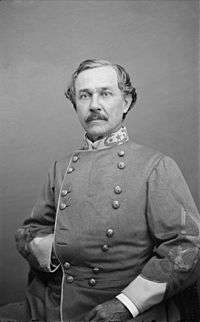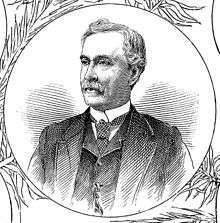Joseph R. Anderson
| Joseph Reid Anderson | |
|---|---|
 | |
| Born |
February 16, 1813 Fincastle, Virginia |
| Died |
September 7, 1892 (aged 79) Isles of Shoals, New Hampshire |
| Place of burial | Hollywood Cemetery Richmond, Virginia |
| Allegiance |
|
| Service/branch |
|
| Years of service |
1836–1837 (USA) 1861–1862 (CSA) |
| Rank |
|
| Battles/wars | |
| Other work | Industrialist |
Joseph Reid Anderson (February 16, 1813 – September 7, 1892) was an American civil engineer, industrialist, and soldier. During the American Civil War he served as a Confederate general, and his Tredegar Iron Company was a major source of munitions and ordnance for the Confederate States Army.[1] Starting with a small forge and rolling mill in the mid-1830s, It was a flourishing operation by 1843 when he leased it. He eventually bought the company outright in 1848 and forcefully and aggressively built Tredegar Iron Works into the South's largest and most significant iron works. When the Civil War broke out he entered the Army as a Brigadier General in 1861. Shortly after he was wounded and then resigned from the Army returning to the iron works. It was the confederacies major and for much of the war only source of cannons and munitions, employing some 900 workers, most of whom slaves. His plant was confiscated by the United States In 1865, but returned to him in 1867 and he remained president until his death. Anderson was very active in local civic and political affairs.
Biography
Early life and career
Joseph Reid Anderson was born at "Walnut Hill" near Fincastle, the county seat of Botetourt County, Virginia in 1813. The grandson of Scotch-Irish immigrants, he was the son of Colonel William Anderson (1764–1839) and Anne (née Thomas) Anderson. The elder Anderson had served in the American Revolutionary War, and was also a colonel of a Virginia regiment in the War of 1812. Joseph's father was a self-taught engineer and surveyor and was later responsible for the building of the turnpike that is now U.S. Route 220 and (for part of the way) U.S. Route 60 from Fincastle to Covington. Col. Anderson's son was to follow in similar work.
Joseph was appointed to the United States Military Academy at West Point, New York, and graduated 4th in his class in 1836. In recognition of his engineering abilities, Anderson was assigned as an assistant engineer in the Engineer Bureau in Washington before being officially transferred to the United States Army Corps of Engineers on July 1, 1837, as a brevet second lieutenant. His primary duty with the Corps of Engineers was in the construction of Fort Pulaski to guard the Port of Savannah, Georgia.
Anderson married Sara Eliza Archer, daughter of Dr. Robert Archer, the post surgeon at Fort Monroe at the entrance to Hampton Roads in Elizabeth City County, Virginia. Seeking better prospects than army life promised, in 1837, he resigned to work as a civil engineer with Virginia State Engineer Claudius Crozet, who had earlier been a professor of engineering at West Point. Under the Virginia Board of Public Works, Anderson became Assistant State Engineer and served was chief engineer of the Valley Turnpike Company, a toll road which extended between Staunton and Winchester, Virginia in the Shenandoah Valley from 1838 until 1841.
In 1841, Anderson joined the Tredegar Iron Company in Richmond, Virginia, eventually becoming its owner in 1848. By 1860, he was a leading industrialist in the South and his foundry on the James River was one of the largest in the United States, producing steam locomotives, boilers, cables, naval hardware, and cannon.
Civil War
When the Civil War came, the Tredegar Iron Company emerged as the industrial heart of the Confederate States of America. Using slave and free labor, Anderson supervised ordnance and munitions production through most of the war.
Anderson, a supporter of southern secession and states' rights, was commissioned a Major of artillery in August 1861, and promoted to brigadier general in the Confederate Army on September 3, 1861. Initially assigned to command the Confederate forces at Wilmington, North Carolina, in April 1862, he was reassigned to the area around Fredericksburg, Virginia, opposite Union Maj. Gen. Irvin McDowell.
With the mounting threat to Richmond during the Peninsula Campaign, Anderson was placed in command of the 3rd Brigade in A.P. Hill's newly formed "Light Division." During the Seven Days Battles, he saw action at Mechanicsville, Gaines' Mill, and was wounded at Frayser's Farm on June 30, 1862.
General Anderson resigned his army commission on July 19, 1862, and served the Confederate war effort in the Ordnance Department until the evacuation of Richmond on the night of April 2–3, 1865. As the retreating Confederate troops burned many of the munitions dumps and industrial warehouses that would have been valuable to the North, Anderson reportedly paid over fifty armed guards to protect the Tredegar facility from arsonists.[2] As a result, the Tredegar Iron Works is one of few Civil War era buildings in the warehouse district that survived the burning of Richmond.
Postbellum activities

During the Federal occupation of Richmond, the U.S. government had confiscated the Tredegar Iron Company's property, but Anderson regained control in 1867 and remained a prominent Virginia businessman as its president. His son, Archer Anderson, became involved in the business, and became president of the Tredegar Iron Works after his father's death. Another son Joseph Reid Anderson, went to the Virginia Military Institute after the Civil War and later taught there; and is considered to be the "Second Founder" of the Alpha Tau Omega Fraternity.
After his wife Sara died in 1881, Anderson remarried. His second wife was Mary Evans Pegram, making him a brother-in-law to Confederate General John Pegram and Colonel William Ransom Johnson Pegram, both of whom had been killed during the war.
Joseph Reid Anderson died while on a vacation at the Isles of Shoals, New Hampshire. It was widely reported that 30,000 citizens came to his funeral when he was buried in Hollywood Cemetery in Richmond, Virginia.
Honors
Today, Anderson's former Tredegar Iron Works facility overlooking the James River near downtown Richmond is the site of the main Visitor's Center of the Richmond National Battlefield Park.
See also
- His great niece, Ellen Glasgow, was a Pulitzer Prize winning American novelist.
- List of American Civil War generals (Confederate)
References
- ↑ Fonvielle, Chris Eugene (1999). Fort Anderson: Battle for Wilmington. Da Capo Press. p. 14. ISBN 9781882810246. Retrieved 14 October 2015.
- ↑ Tucker, Spencer (2013). American Civil War: The Definitive Encyclopedia and Document Collection. ABC-CLIO. p. 2592. ISBN 9781851096824. Retrieved 14 October 2015.
Further reading
- Dew, Charles. Ironmaker to the Confederacy: Joseph R. Anderson and the Tredegar Iron Works (Yale University Press, 1966). Pp. xiv, 345.
